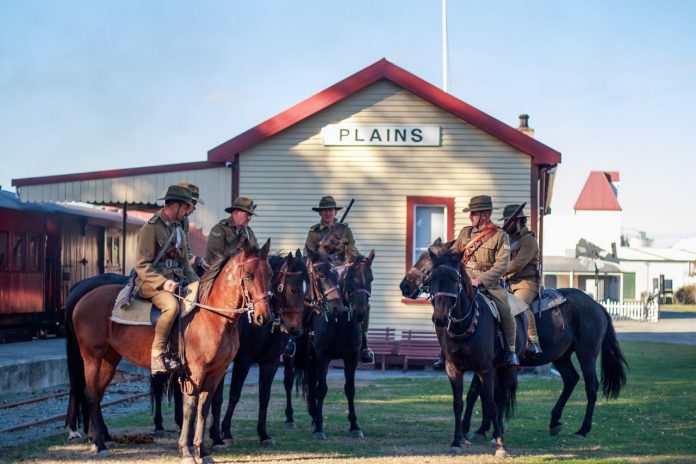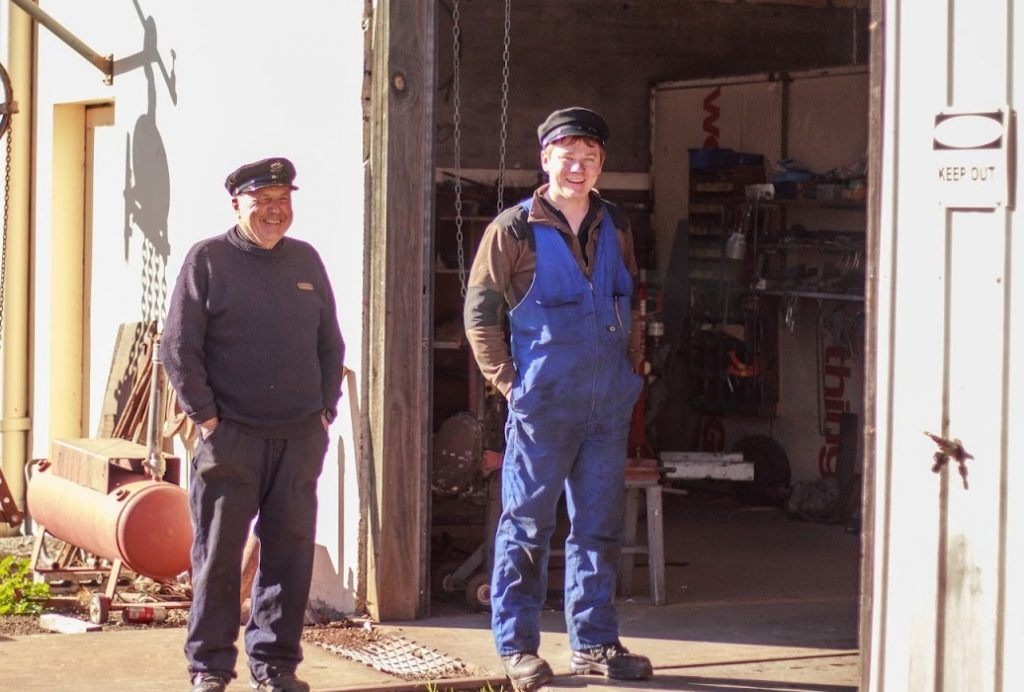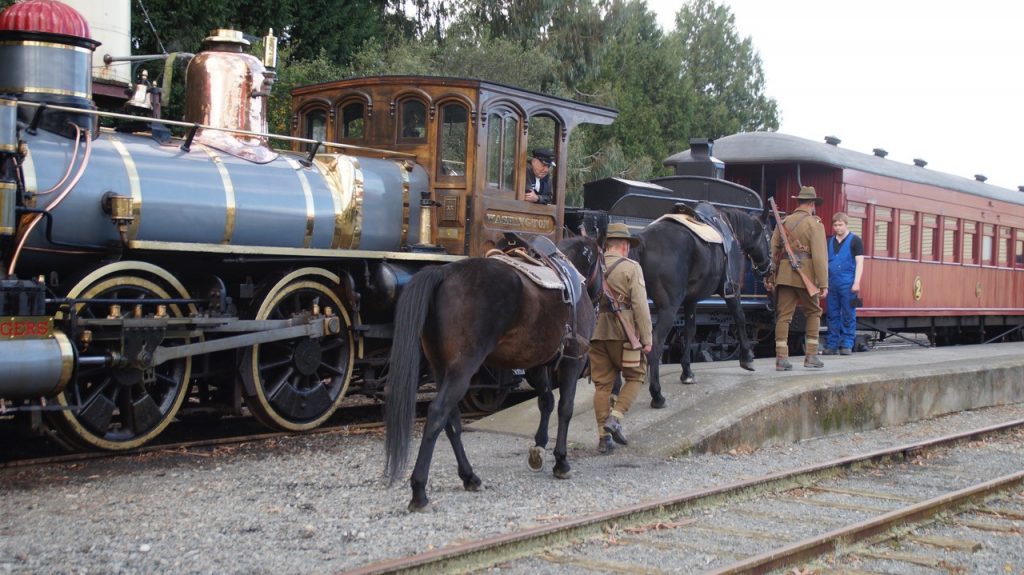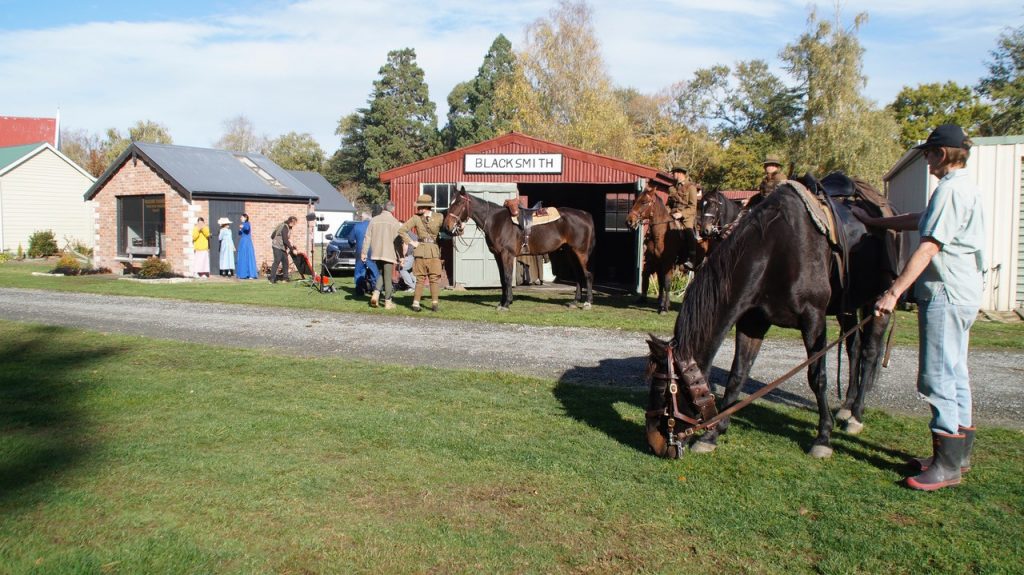
Four Plains members have performed as extras in powerful scenes of soldiers and horses off to the battlefields of World War 1.
They were Neil Salter as a steam train driver, Scott Thomson as a fireman, Mike Ross as a guard, and Glenn Brien as a blacksmith. Brien’s daughter Paige, 12, and her friend Lilly Kelly, 12, also star, as curious school children.
The scenes, which involved acting but no lines, are for a New Zealand 90-minute film documentary to be released on Armistice Day, November 11, this year.
Devils on Horses – Soldiers, Horses and the Trauma of War
will be about the New Zealand Mounted Rifles Brigade which fought in WW1.
The film is a project of the Anzac Mounts Charitable Trust.
The extras were part of the action as six horses, actors and a small film crew spent three days late last month at the Plains, one of the last of multiple filming locations used.
The project has been in the making for about six years. Last year the trust met with the Plains to organise the filming. The members who performed as extras were chosen as they were available on the day.

Following the filming, the Plains extras are beaming.
Brien, the blacksmith, said it had been ‘‘a once in a lifetime opportunity’’.
‘‘It was awesome to be a part of it all,’’ Brien said.
‘‘It’s quite daunting going into a production like that and not having any acting experience. They were clear with what I needed to do. I had to make a cinematic version of a horse shoe. Lots of sparks flying and big firing and big hits with the hammer,’’ he said.
Brien had been particularly honoured to take part in the film, being a former mounted trooper with the New Zealand Army himself. In the late 1990s he was a member of Queen Alexandra’s Mounted Rifles.
Salter’s job was to drive the Plain’s iconic K88.
The 73-year-old said being involved was a highlight of his train-driving career.
‘‘I liked learning a bit more about that side of our history, and seeing these guys reenacting it,’’ Salter said.
One of his scenes involved him leaning from the train’s cab window and watching as his fellow actors of soldiers, and their horses, walked up on to the train platform.

The crew also filmed Salter driving the train. He said driving the steam train is something that comes naturally to him. It was a job he loved, and one he had been doing voluntarily at the Plains for five years. ‘‘A diesel locomotive you turn the key and it starts, these things you start from scratch, get them hot and make them go, it’s like they are alive.’’
He said the six horses had been calm and easy to work with, even as they came close to the hissing and tooting steam engine.
Thomson, 21, said his role as fireman also involved activities he usually did of shovelling coal and putting water in the boiler, and walking along the train platform.
The longest day of filming was almost 12 hours from 6.30am, involving takes and retakes.
Ross, 71, said his role as guard involved blowing a whistle and waving a green flag, signalling the train leaving the platform.
‘‘A lot of it, you just stood around and didn’t do much, and I was just doing what I normally do.’’
Producer and chair of the trust, Terry Kingi of Hawarden, was impressed with how well filming had gone at the Plains. He said it was a rare occasion to be able to get footage of horses next to a steam train in operation, but that is what they had managed to do.

‘‘The horses didn’t play up or anything,’’ he said.
The Plains extras were ‘‘brilliant’’.
‘‘They were a credit to the museum, we were very proud of them.’’
None would end up on the cutting room floor, all would appear in the film.
Kingi said Devils on Horses would be different from a normal documentary, in that its focus would be on the wellbeing of the soldiers and the horses.
An unreleased trailer shows historians talking about the trauma suffered.
Military historian Dr Aaron Fox said the horses trusted their riders enough to go into battle.
‘‘Charging into a maelstrom where you are being shot at, shelled, machine gunned,’’ Fox said.
‘‘Do horses have nightmares? I’m sure they would.’’
It was just as difficult for the mounted soldiers.
‘‘People are dying, and horses are dying all around you, but you still do the job you are there to do. (Your horse) looks to you with those big eyes, and your best mate in the world is shot beneath you, that’s devastating.’’
Kingi himself has a family association with the mounted rifles; his great grandfather John Copple of Takaka was one of them. Trooper Copple was among soldiers forced to shoot their own horses who had served with them before they came home. Of the 10,500 Kiwi horses which went to the war, only four returned.
‘‘He never really spoke about it. When he came home, he smuggled his bridle, but he never rode another horse from that day.’’
Kingi said the horses for WW1 had mostly been donated by runholders. The ones from Ashburton were loaded on to special horse carriages to be taken by train to Christchurch, by boat to Trentham, before being shipped to the Suez Canal for battle.
There had been 33 mounted soldiers go from the Ashburton District. Only 15 came home.
He said the film would screen at overseas film festivals and in New Zealand cinemas.
‘‘So Ashburton will well and truly be on the map.’’



